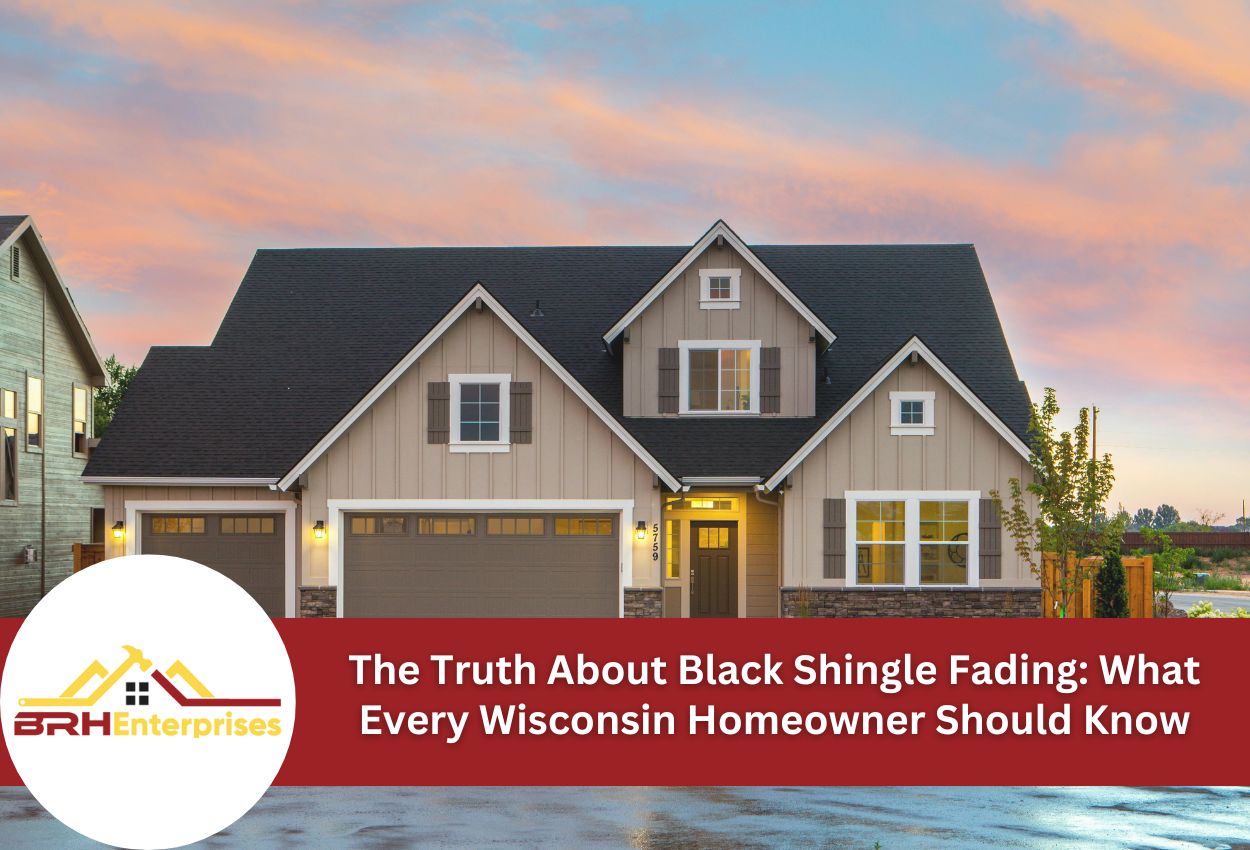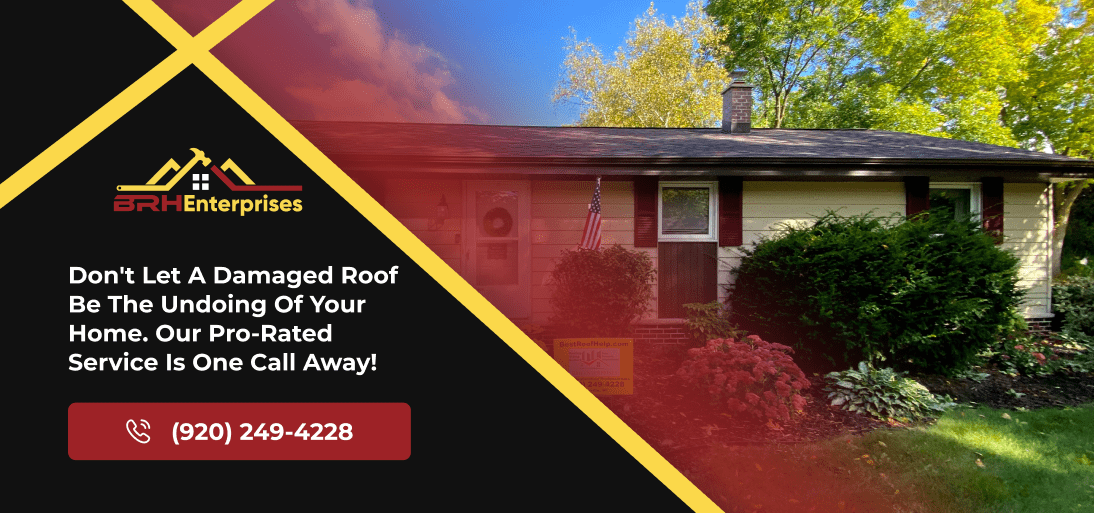The Truth About Black Shingle Fading: What Every Wisconsin Homeowner Should Know
Estimated Reading Time : 6 Min.

Black shingles make a bold statement on any home, creating a sleek, sophisticated look that many Southern Wisconsin homeowners prefer. However, a common question that arises when considering this popular roofing option is: Do black shingles fade over time? The short answer is yes — all asphalt shingles, including black ones, experience some degree of fading throughout their lifespan. This natural process occurs due to constant exposure to UV rays, extreme temperature changes, and the harsh Wisconsin weather conditions that cycle between intense summer heat and frigid winters.
The science behind what causes black shingles to fade lies in the shingle composition. Black asphalt shingles get their color from granules coated with dark pigments that absorb sunlight. Over time, these pigments break down due to UV exposure, causing the rich black color to gradually lighten. Wisconsin’s seasonal weather patterns, with freeze-thaw cycles and heavy precipitation, can accelerate this process. While modern manufacturing techniques have improved black architectural shingles’ fade resistance significantly, no shingle is completely immune to color changes.
Understanding how black roof discoloration happens and what factors influence color retention can help homeowners make informed decisions about their choice in roofing material and maintain their roof’s appearance for years to come.
Factors That Cause Black Shingles to Fade
Wisconsin’s seasonal weather patterns play a big role in how quickly black shingles lose their deep, rich color. During our harsh winters, the freeze-thaw cycles cause expansion and contraction that gradually wear down the protective granule coating. In summer, intense UV radiation combined with high humidity also breaks down the color pigments, especially on south and west-facing roof sections that receive direct sunlight for most of the day.
Beyond weather conditions, several other factors contribute to black shingle fading. Manufacturing quality makes a major difference, as premium black architectural shingles with higher-quality color-fast granules and UV inhibitors maintain their appearance significantly longer than budget options. Proper installation techniques also matter, as incorrect nailing or the wrong type of underlayment can lead to premature aging and color degradation.
Roof ventilation is another critical factor many homeowners forget to consider. Inadequate attic ventilation creates excessive heat buildup that literally cooks shingles from underneath, accelerating color loss. Professional roofing contractors in Southern Wisconsin understand how to design ventilation systems that extend black shingle color retention by maintaining appropriate temperature levels.
The quality of initial algae resistance technology in the shingles also affects long-term appearance, as black roofs are particularly prone to visible streaking that can make fading appear worse than it actually is.
Timeline: How Long Before You’ll Notice Fading on Black Shingles
Understanding when your black shingles will begin to show signs of fading helps set realistic expectations for your Wisconsin home. For standard black asphalt shingles, you’ll typically notice subtle color changes starting around years 3 through 5, with more pronounced fading occurring between years 5 through 7. Premium architectural black shingles with enhanced UV protection generally maintain their rich color longer, often showing minimal fading until years 7 through 10 in Wisconsin’s challenging climate.
The visual progression of fading follows a predictable pattern. During years 1 to 3, your black roof should maintain its deep, uniform appearance with minimal changes. Between years 3 and 5, you might notice slight dulling and loss of the intense black color, particularly on south-facing slopes. By years 5 to 10, standard shingles typically develop a more weathered charcoal appearance, while premium products retain more of their original depth. After 10+ years, most black shingles settle into a permanent grayish-black tone.
It’s important to distinguish normal fading from premature issues. Normal fading appears as an even, gradual lightening across the entire roof surface. Concerning signs include patchy discoloration, streaking unrelated to algae, or dramatic color loss within the first 1 to 2 years. Wisconsin homeowners who notice these symptoms should consult with a professional roofing contractor to determine if warranty coverage applies or if other roofing problems are contributing to the accelerated color changes.
Comparing Black Shingle Options: Which Resists Fading Best?
Not all black shingles are created equal when it comes to fade resistance. In our Wisconsin climate, architectural black shingles typically outperform standard 3-tab varieties, maintaining their color 30% to 50% longer under identical conditions. Premium designer black shingles offer even better performance, with specialized color-lock technology that can extend rich black color for several additional years compared to basic options.
Recent manufacturing innovations have dramatically improved shingle color retention as well. Leading manufacturers now incorporate advanced UV inhibitors directly into the asphalt mixture rather than just the surface granules, creating multi-layer protection against solar degradation. Some newer black shingles feature ceramic-coated granules with specialized reflective properties that maintain color while redirecting harmful rays away from the shingle base.
When evaluating black shingle options for your Southern Wisconsin home, look for products advertising color-fast technology or lifetime color protection. These typically contain copper-infused granules that simultaneously prevent algae growth while stabilizing pigments against UV breakdown. GAF’s Timberline HDZ® shingles in Charcoal and Owens Corning’s TruDefinition Duration® shingles in Onyx Black consistently demonstrate excellent color retention in Wisconsin’s challenging climate conditions, making them popular recommendations among local roofing professionals.
Preventative Measures: Protecting Your Black Shingles From Premature Fading
While some color change is inevitable over time, Wisconsin homeowners can take proactive steps to significantly slow the fading process. Regular maintenance is your first line of defense against premature color loss. Schedule annual roof inspections, ideally in spring after winter’s harsh conditions, and again in fall before snow arrives. During these inspections, clear any debris that traps moisture against shingles and check for loose or damaged sections that might make wear worse.
Maintaining proper attic ventilation is crucial for preserving black shingle color. Excessive heat buildup accelerates granule loss and color degradation. Consider having a professional roofing contractor evaluate your current ventilation system. They can recommend improvements such as additional roof vents, soffit vents, or ridge vents specifically designed for Wisconsin’s climate extremes.
For existing black roofs showing early signs of fading, you might want to consider several types of professional treatments. Specialized roof cleaning to remove algae and moss not only improves appearance but also prevents biological organisms from degrading shingle surfaces. Professional-grade acrylic roof coatings designed specifically for asphalt shingles can refresh color while adding a protective UV-resistant layer. Some roofing contractors offer specialized algae-resistant treatments that can be applied to existing roofs, minimizing the streaking that often makes fading appear worse than it actually is.
Restoration Options: Can Faded Black Shingles Be Revitalized?
There are some tactics you can take on in order to restore your shingles and extend the amount of time needed before replacing them.
Restoration starts with a professional cleaning to remove surface contaminants like dirt, algae, and moss that make fading appear worse than it actually is. Using specialized low-pressure washing techniques, experienced roofing contractors can safely eliminate these biological elements without damaging the granules, sometimes resulting in a noticeably improved appearance.
Roof coatings represent another potential restoration option, though results vary significantly based on the existing shingle condition. Acrylic-based shingle rejuvenators can temporarily restore some color while adding a protective layer against further UV damage. However, Wisconsin homeowners should proceed with caution, since not all coatings perform well in our extreme freeze-thaw cycles. Look for products specifically engineered for northern climates that maintain flexibility during temperature fluctuations.
Unfortunately, there comes a point when restoration efforts provide diminishing returns. When granule loss becomes extensive, or when shingles show curling, cracking, or brittleness alongside fading, these are signals that the roof is approaching the end of its functional lifespan. In these cases, investing in high-quality replacement shingles with advanced color retention technology represents the most cost-effective long-term solution. A reputable Southern Wisconsin roofing contractor can provide an honest assessment of whether restoration or replacement makes more sense for your specific situation.
Making an Informed Decision: Is a Black Roof Right for Your Wisconsin Home?
Deciding whether black shingles are the right choice for your Wisconsin home requires weighing both the aesthetic benefits and practical considerations. Black roofs undeniably create a bold, sophisticated look that enhances curb appeal and complements virtually any architectural style. They can make a small home appear larger and add depth to your property’s visual profile. However, this striking appearance comes with tradeoffs in our Wisconsin climate.
When making your decision, consider your property’s specific conditions. Homes with substantial shade from mature trees may help to maintain black shingle coloration longer than fully exposed properties. Your roof’s pitch also impacts the rate of fading, since steeper roofs tend to shed water and snow more efficiently, potentially extending color retention.
For homeowners set on a dark appearance but concerned about fading, consider alternative options like dark brown, charcoal gray, or mixed-tone dark shingles. These colors provide a similar sophisticated appearance while showing less obvious color changes. Many premium architectural shingles now offer blended color patterns that naturally disguise minor fading while maintaining the dramatic visual impact Wisconsin homeowners desire.
Restore or Replace Your Faded Black Shingles with the Help of BRH Enterprises LLC
If you’re worried about the longevity and appearance of your roof, knowing the best ways for black shingles to resist fading is crucial. At BRH Enterprises LLC, we specialize in providing top-tier roofing solutions that ensure your home not only looks great, but stands up to the demanding Wisconsin weather.
Don’t let fading diminish the beauty of your home. Opt for black shingles that are designed to withstand the elements and maintain their color. Call BRH Enterprises LLC today at (920) 249-4228 to discuss your roofing needs and explore our range of high-quality shingle options. Protect your investment with a roof that stays vibrant and durable year after year.


